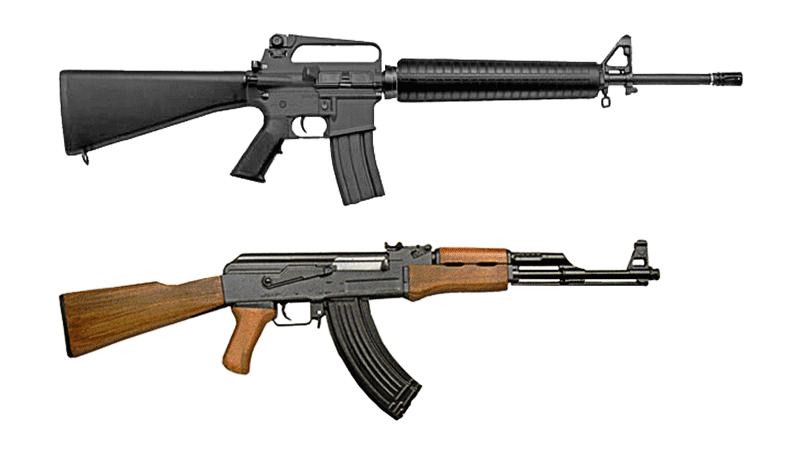AK-47 was designed to use the production methods that were state of the art in the Soviet Union in the late '40s. This implied it more or less used the same methods of construction as the PPSh-41 and PPS-43.The design of an automatic rifle was in the works in Russia before World War II even began. The Avtomat Kalashnikov barrel and bolt were milled out of a steel billet. Its receiver, which was at first milled, was later formed from sheet metal stampings, simplifying manufacture and reducing the weight of the rifle. In order to be able to use a steel grade that was easy to machine, the barrel and bore were hard chromed. The stock was simply made out of wood, which was a non-strategic material, and perfectly fit the Soviet manufacturing philosophy, where large plants using untrained labor could manufacture basic weapons cheaply and in very large quantities.
Another feature typical of Soviet assault rifles is the capability of the AK-47 to fire under very adverse conditions. This can be attributed to the bad experience the Soviet Union had during the early stages of WW2, where it lacked proper ammunition production facilities. Thus, until 1943, the Soviet Union was reduced to using some very poor powders in its ammunition, leaving heavy residue in the guns using it. The Soviets also had learned early on that during a major conflict there is little time to train soldiers to keep their weapons clean.
Vietnam war veteran David H. Hackworth recalled,
“
One of the bulldozers uncovered the decomposing body of an enemy soldier, complete with AK-47. I happened to be standing right there, looking down into the hole and pulled the AK out of the bog. "Watch this, guys," I said, "and I'll show you how a real infantry weapon works." I pulled the bolt back and fired 30 rounds — the AK could have been cleaned that day rather than buried in glug for a year or so. That was the kind of weapon our soldiers needed, not the confidence-sapping M16.
”
Over time, AK-47 descendants have been simplified through the use of spot welding and by further reducing the number of machined parts. The Izhevsk factory manufacturing descendants like the AK-101 can produce around 24,000 units a day. Because of its design it is not possible to manufacture the AK-47 series efficiently in small plants, due to large amount of metal stamping equipment needed for mass production. However, the AK-47 has been copied and manufactured in small shops all around the world, at the expense of more man hours per unit.
[edit] M16
Main article: M16 rifle
An early M16 rifle: note "tulip" flash hider, triangular handguard, and the lack of forward assist, as well as the older-style rear sight assembly
During the later '50s, when Colt bought the blueprints of the AR-15 (M16) from ArmaLite, there had been many improvements in the field of machining equipment, the biggest being the introduction of numerical control machines.
The objective was to design a new assault rifle that was easy to carry and manufacture in early automated plants using numerical control machining. It was to use a smaller caliber bullet to allow the soldier to carry more ammunition, which increased his firepower while also enabling him to obtain a higher hit probability. The M16 would achieve all these objectives by using all the latest technologies of its day.
The M16's 5.56 mm M193 bullet would sometimes fragment on impact, and thus create wounds that were out of proportion to its caliber. The 7.62x39 mm round of the AK-47 generally does not fragment, but "is still quite deadly having an unusual tendency to remain intact even after taking unusual deviations upon contact with bone."[1]
Unlike all the other gas operated modern assault rifles, the M16 does not have a separate piston. Rather, it directs the gas into a small chamber inside the bolt carrier, and thus pushes the bolt carrier back directly. This system works well provided clean burning powders are used in the ammunition. The primary advantage of this system is enhanced accuracy when firing full automatic. It also reduces felt recoil to a very low level. The main disadvantage is it introduces fouling into the receiver, which mandates frequent cleaning and oiling. One early major improvement was to also hard chrome the barrel and chamber, which reduced spent case ejection problems plaguing the very first M16s. Over time, however, many small changes have improved the reliability of the M16. Reliability issues with first production version were worked out later in the Vietnam conflict by re-introducing stick powder into the ammunition, as opposed to ball powder which would swell the cartridge casing and cause jamming. The forward assist was also added to the M16 Army Variant (the Air Force had made the forward assist a condition of acceptance), which allowed for the correction of the situation where the bolt would fail to fully push a cartridge out of the magazine and into the chamber.


